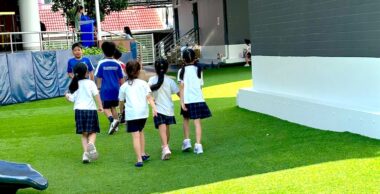The journey of helping our AADC-deficient child gain independence
Anxiety and medical needs can make letting go a challenge
Written by |

Raising our daughter, Rylae-Ann, has been an incredible journey full of lessons and challenges, requiring use to consistently reshape our expectations. With more than a decade of teaching experience, I thought I was prepared for the ups and downs of parenting, but nothing truly prepared me for raising a child with the rare disorder aromatic l-amino acid decarboxylase (AADC) deficiency.
Together, my wife, Judy, and I have navigated a path that is at times heartbreaking, often uncertain, but always deeply rewarding. Our journey, guided by trial and error and the relentless pursuit of what’s best for Rylae-Ann, has taught us as much about patience as it has about resilience.
When Rylae-Ann was 18 months old, she received gene therapy, which gave her a new lease on life and, for the first time, made a future of independence feel possible. Independence was our dream for her — not just physically, but emotionally, too. To achieve this, however, she’d first need to learn to separate from us — a concept that, while routine for many children, felt monumental for Rylae-Ann.
The first steps toward separation
We began our journey slowly. When Rylae-Ann was 2, we joined as many group activities as possible and eventually enrolled her in preschool. However, any hint of us stepping away from her would trigger intense anxiety and tears. Despite our desire to give her space, her need for support meant that one of us was always nearby, shadowing her as she navigated these new social settings. She required a lot of support in these situations as she continued to build strength and motor control.
Gradually, as her skills grew, Judy and I tried stepping back, letting her explore without us right by her side. But each time, Rylae-Ann’s instinctive reaction was to cling to us, her tears filling the room as she cried out for her parents. The separation was painful for all of us, and we wondered if there were a way forward that would allow her to grow without overwhelming her.
A new milestone in kindergarten
When Rylae-Ann started kindergarten, the need for independence became more pressing. With both of us working, Judy and I had to trust that our daughter could manage without us there. Initially, a shadow teacher was essential to help her navigate her school days, and we were fortunate to find one who was both supportive and compassionate.
But saying goodbye each morning was heart-wrenching. As we turned to leave, Rylae-Ann would run after us, tears streaming, her familiar scream echoing down the hallway.
By the end of kindergarten, she no longer needed a shadow teacher, but our mornings were still filled with tearful farewells and frustration. We tried everything — reassuring words, shortened goodbyes, incentives for independence — but nothing worked. Watching her struggle through these goodbyes weighed on us, and there were days we weren’t sure if our efforts were doing more harm than good.
Learning to let go in first grade

Rylae-Ann Poulin happily walks away with her friends in the morning. (Courtesy of Richard E. Poulin III)
When Rylae-Ann began first grade, Judy and I accepted the routine and approached our goodbyes with patience instead of frustration. We resolved not to push for a “perfect” separation, but to let her find her way at her own pace.
Then, something changed — slowly, almost imperceptibly at first. One morning, Rylae-Ann surprised us with a cheerful wave, a quick kiss, and a bright smile as she said goodbye. Over the next few days, that became her new routine. She walked into her classroom proudly, waving us off and excitedly rejoining her friends. This week, she even told her mom to stay back, proudly declaring that she could handle it herself.
Trusting in time, space, and Rylae-Ann
This shift was not the result of a secret strategy or an online tip, but of time, trust, and the space we allowed her to find her confidence. Rylae-Ann’s journey to independence didn’t come from a “one-size-fits-all” solution; rather, it grew from our willingness to trust her, give her time, and let her develop at her own pace.
Separation is a journey for both children and parents. As Rylae-Ann learned to step away from us, we learned to step back, knowing she would be OK. So to every parent navigating the delicate balance of letting go, trust your instincts, trust your child, and trust the journey — even when it looks different from everyone else’s. Each child’s story is unique; sometimes the best outcomes come from simply allowing that story to unfold in its own time.
Note: AADC News is strictly a news and information website about the disease. It does not provide medical advice, diagnosis, or treatment. This content is not intended to be a substitute for professional medical advice, diagnosis, or treatment. Always seek the advice of your physician or other qualified health provider with any questions you may have regarding a medical condition. Never disregard professional medical advice or delay in seeking it because of something you have read on this website. The opinions expressed in this column are not those of AADC News or its parent company, Bionews, and are intended to spark discussion about issues pertaining to aromatic l-amino acid decarboxylase deficiency.





Leave a comment
Fill in the required fields to post. Your email address will not be published.